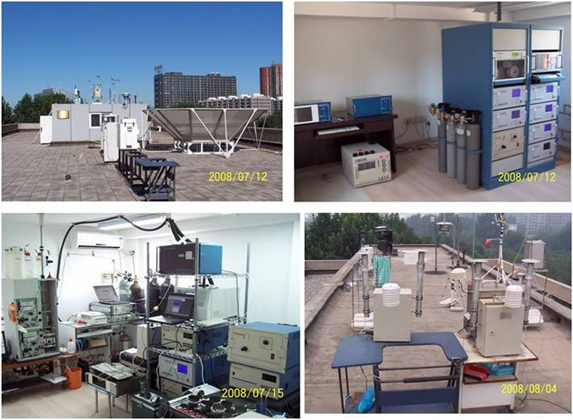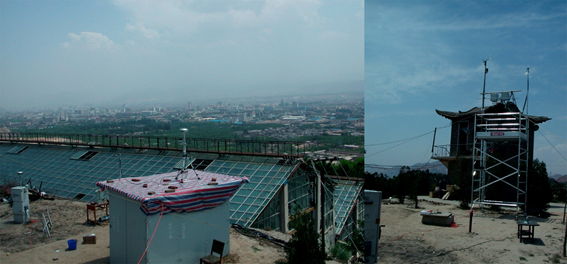Field study in Beijing, Shanghai and Lanzhou


Impact of mega-cities on regional air quality: Field measurements were carried at sites downwind of Beijing, Shanghai, and Lanzhou to improve the understanding of emission, chemical transformation, and impacts on regional air quality of urban plumes from large and maga- cities in China with different energy use and/or meteorological conditions. We measured ozone and ozone precursors (NO, NOy, NMHCs), other gases (CO, SO2, PAN, NH3), and aerosols physical and chemical properties, including particle size distribution, time-resolved water soluble ions, filter-based aerosol chemistry, and absorption and scattering coefficients. We also measured PAN in China using a state-of-the-art GC with an online calibration system. The field studies in Beijing and Shanghai were in the summer of 2005 and in summer 2006 in Lanzhou. This study was conducted in collaboration with Shandong University. The study in Lanzhou received collaboration from Lanzhou University.
Beijing 2008 summer Olympics: In the summer of 2008, trace gases and aerosols were measured at three surface sites in and around Beijing before and during the 2008 Olympics to assess the impact of pollution-control measures on air quality, ozone and aerosol chemistry. The 2008 study was conducted with collaboration of Shandong University and Chinese Research Academy of Environmental Sciences. Analyses of the data collected from the study are on-going.
The results show:
(1) Very serious ozone pollution, with 1-hr O3 reaching 286 ppbv, was observed downwind Beijing (Wang et al., 2006).
(2) We found that the formation of significant amount of fine nitrate aerosol in ammonia-poor atmosphere in Shanghai and Beijing, which is different from previous studies in other places in the world, and it is hypothesized that this was due to the enhanced hydrolysis in the presence of large aerosol surface areas and high aerosol acidity (Pathak et al., 2009).
(3) We found the problem of a semi-continuous ion instrument under the condition of high loading aerosols and SO2 in China. Positive and negative bias in the real-time instrument was found when comparing with conventional filter-based method (Wu and Wang, 2007).
(4) We also analyzed ozone data collected near Beijing from the MOZAIC program to provide the first ozone climatology over Beijing (Ding et al., 2008).
(5) The large BC/CO ratio in Shanghai than in Beijing is attributed to the large consumption of diesel by vehicles and marine vessels in Shanghai. The latter results have been used to estimate the emission of BC from the two mega-cities (Zhou et al., 2009).
(6) Formation and growth of new particles was observed under conditions of high concentrations of sulfur dioxide and aerosol near Shanghai (Gao et al., 2009).
Related References:
- Ding, A. J., T. Wang *, V. Thouret, J. P. Cammas, and P. Nedelec. "Tropospheric Ozone Climatology over Beijing: Analysis of Aircraft Data from the Mozaic Program." Atmospheric Chemistry and Physics 8, no. 1 (2008): 1-13. http://dx.doi.org/10.5194/acp-8-1-2008.
- Wu, W. S. and T. Wang *. "On the Performance of a Semi-Continuous Pm2.5 Sulphate and Nitrate Instrument under High Loadings of Particulate and Sulphur Dioxide." Atmospheric Environment 41, no. 26 (Aug 2007): 5442-51. http://dx.doi.org/10.1016/j.atmosenv.2007.02.025.
- Wang, T. *, A. J. Ding, J. Gao, and W. S. Wu. "Strong Ozone Production in Urban Plumes from Beijing, China." Geophysical Research Letters 33, no. 21 (Nov 2006): 5. http://dx.doi.org/10.1029/2006gl027689.
- Pathak, R. K., W. S. Wu, and T. Wang *. "Summertime Pm2.5 Ionic Species in Four Major Cities of China: Nitrate Formation in an Ammonia-Deficient Atmosphere." Atmospheric Chemistry and Physics 9, no. 5 (2009): 1711-22. http://dx.doi.org/10.5194/acp-9-1711-2009.
- Zhang, J. M., T. Wang *, A. J. Ding, X. H. Zhou, L. K. Xue, C. N. Poon, W. S. Wu, J. Gao, H. C. Zuo, J. M. Chen, X. C. Zhang, and S. J. Fan. "Continuous Measurement of Peroxyacetyl Nitrate (Pan) in Suburban and Remote Areas of Western China." Atmospheric Environment 43, no. 2 (Jan 2009): 228-37.
http://dx.doi.org/10.1016/j.atmosenv.2008.09.070.
- Zhou, X. H., J. Cao, T. Wang *, W. S. Wu, and W. X. Wang. "Measurement of Black Carbon Aerosols near Two Chinese Megacities and the Implications for Improving Emission Inventories." Atmospheric Environment 43, no. 25 (Aug 2009): 3918-24. http://dx.doi.org/10.1016/j.atmosenv.2009.04.062.
- Wang, T. *, W. Nie, J. Gao, L. K. Xue, X. M. Gao, X. F. Wang, J. Qiu, C. N. Poon, S. Meinardi, D. Blake, S. L. Wang, A. J. Ding, F. H. Chai, Q. Z. Zhang, and W. X. Wang. "Air Quality During the 2008 Beijing Olympics: Secondary Pollutants and Regional Impact." Atmospheric Chemistry and Physics 10, no. 16 (2010): 7603-15. http://dx.doi.org/10.5194/acp-10-7603-2010.
- Nie, W., T. Wang *, X. M. Gao, R. K. Pathak, X. F. Wang, R. Gao, Q. Z. Zhang, L. X. Yang, and W. X. Wang. "Comparison among Filter-Based, Impactor-Based and Continuous Techniques for Measuring Atmospheric Fine Sulfate and Nitrate." Atmospheric Environment 44, no. 35 (Nov 2010): 4396-403.
http://dx.doi.org/10.1016/j.atmosenv.2010.07.047.
|



